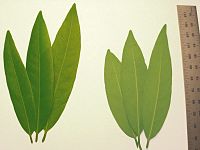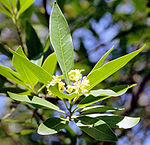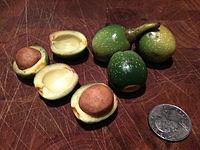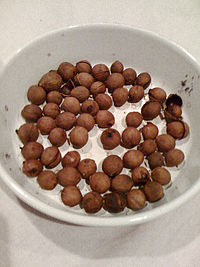- Umbellularia
-
Umbellularia californica 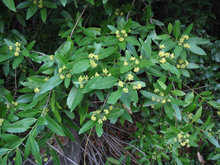
Foliage and flowers Scientific classification Kingdom: Plantae (unranked): Angiosperms (unranked): Magnoliids Order: Laurales Family: Lauraceae Genus: Umbellularia
(C.G.D.Nees) NuttallSpecies: U. californica Binomial name Umbellularia californica
(Hook. & Arn.) Nutt.Synonyms Sciadiodaphne Rchb.
Umbellularia californica is a large tree native to coastal forests of California and slightly extended into Oregon.[1]
It is the sole species in the genus Umbellularia.
Its pungent leaves have a similar flavor to bay leaves (though stronger), and it may be mistaken for Bay Laurel.
Contents
Nomenclature
In Oregon, this tree is known as Oregon Myrtle, while in California it is called California Bay Laurel, which may be shortened to California Bay or California Laurel. It has also been called Pepperwood, Spicebush, Cinnamon Bush, Peppernut Tree and Headache Tree. This hardwood tree is endemic to the California Floristic Province. The dry wood has a color range from blonde (like maple) to brown (like walnut). Myrtlewood is considered a world-class tonewood and is sought after by luthiers and woodworkers from around the world.
Habitat
This tree mostly inhabits Redwood forests, California mixed woods, Yellow Pine Forest, and oak woodlands. Bays occur in oak woodlands only close to the coast or in extreme northern California where it is moister.
During the Miocene, oak-laurel forests were found in Central and Southern California Laurel forest. Typical tree species included oaks ancestral to present-day California oaks, as well as an assemblage of trees from the Laurel family, including Nectandra, Ocotea, Persea, and Umbellularia.[2][3] Only one native species from the Laurel family, Umbellularia californica, remains in California today.
Distribution
In the north, it reaches its distributional limit near Coos Bay Douglas County, Oregon on the coast, extending from there south through California to San Diego County. It is also found in the western foothills of the Sierra Nevada mountains. It occurs at altitudes from sea level up to 1600 m.
Description
It is an evergreen tree growing to 30 m tall (exceptionally 45 m) with a trunk up to 80 cm thick.
The fragrant leaves are smooth-edged and lens shaped, 3–10 cm long and 1.5–3 cm broad, similar to the related Bay Laurel though usually narrower, and without the crinkled margin of that species.
The flowers are small, yellow or yellowish-green, produced in a small umbel (hence the scientific name Umbellularia, "little umbel").
The fruit, also known as "California Bay nut", is a round and green berry 2–2.5 cm long and 2 cm broad, lightly spotted with yellow, maturing purple. Under the thin, leathery skin, it consists of an oily, fleshy covering over a single hard, thin-shelled pit, and resembles a miniature avocado. Genus Umbellularia is in fact closely related to the avocado's genus Persea, within the Lauraceae family. The fruit ripens around October–November in the native range.
The California Bay is the primary foliar host for Sudden Oak Death (SOD).
Uses
Historical usage
Umbellularia has long been valued for its many uses by Native Americans throughout the tree's range, including the Cahuilla, Chumash, Pomo, Miwok, Yuki, Coos and Salinan people.[4]
The leaf has been used as a cure for headache, toothache, and earache—though the volatile oils in the leaves may also cause headaches.[5] Poultices of Umbellularia leaves were used to treat rheumatism and neuralgias.[6] Laurel leaf tea was made to treat stomach aches, colds, sore throats, and to clear up mucus in the lungs.[7] The leaves were steeped in hot water to make an infusion that was used to wash sores.[6] The Pomo and Yuki tribes of Mendocino County treated headaches by placing a single leaf in the nostril or bathing the head with a laurel leaf infusion.[7]
The chemical responsible for the headache-inducing effects of Umbellularia is known as Umbellulone.[8]
Both the flesh and the inner kernel of the fruit have been used as food by Native Americans. The fatty outer flesh of the fruit, or mesocarp, is palatable raw for only a brief time when ripe; prior to this the volatile aromatic oils are too strong, and afterwards the flesh quickly becomes bruised, like that of an overripe avocado.[9] Native Americans dried the fruits in the sun and ate only the lower third of the dried mesocarp, which is less pungent.[7]
The hard inner seed underneath the fleshy mesocarp, like the pit of an avocado, cleaves readily in two when its thin shell is cracked. The pit itself was traditionally roasted to a dark chocolate-brown color, removing much of the pungency and leaving a spicy flavor.[6] Roasted, shelled "bay nuts" were eaten whole, or ground into powder and prepared as a drink which resembles unsweetened chocolate. The flavor, depending on roast level, has been described variously as "roast coffee," "dark chocolate" or "burnt popcorn".[10] The powder might also be pressed into cakes and dried for winter storage, or used in cooking.[6] It has been speculated that the nuts of U. californica contain a stimulant;[11][12][13] however this possible effect has been little documented by biologists.
Modern usage
The leaf can be used in cooking, but is spicier and "headier" than the Mediterranean bay leaf sold in groceries, and should be used in smaller quantity. Umbellularia leaf imparts a somewhat stronger camphor/cinnamon flavor compared to the Mediterranean Bay.[14] The two Bay trees are related within the Laurel family, along with the Cinnamons.
Some modern-day foragers and wild food enthusiasts have revived Native American practices regarding the edible roasted fruit, the bay nut.[9][15][16]
U. californica is also used in woodworking. It is considered a tonewood, used to construct the back and sides of acoustic guitars. The wood is very hard and fine, and is also made into bowls, spoons, and other small items and sold as "myrtlewood".
U. californica is also grown as an ornamental tree, both in its native area, and elsewhere further north up the Pacific coast to Vancouver in Canada, and in western Europe. It is occasionally used for firewood.
One popular use for the leaves is to put them between the bed mattresses to get rid of, or prevent flea infestations.
"Myrtlewood" money
"Myrtlewood" is the only wood still in use as a base "metal" for legal tender.[17] During the "interregnum of despair" between Franklin Roosevelt's election and his inauguration, the only bank in the town of North Bend, Oregon -- the First National—was forced to temporarily close its doors, precipitating a cash-flow crisis for the City of North Bend. The city solved this problem by minting currency using myrtlewood discs printed on a newspaper press. These coins, in denominations from 25 cents to $10, were used to make payroll and the city promised to redeem them for cash as soon as it became available.
However, when the bank reopened and the city appealed for people to bring their myrtlewood money in to redeem it, many opted to keep their tokens as collector's items. After several appeals, the city gave up and announced that the tokens would remain legal tender in the city of North Bend in perpetuity. Until the 1960s, people occasionally did cash in their tokens, but the remaining pieces have become very valuable through scarcity and historical interest. Fewer than 10 full sets are believed to exist.[18]
Pathology
California Bay Laurel is an important host of Sudden oak death and often reside in forests with Tanoaks, which are also vulnerable to the disease.
Notes
- ^ "Umbellularia californica". CalFlora. http://www.calflora.org/cgi-bin/species_query.cgi?where-calrecnum=8183. Retrieved 12 January 2010.
- ^ Axelrod, Daniel I. (2000) A Miocene (10-12 Ma) Evergreen Laurel-Oak Forest from Carmel Valley, California. University of California Publications: Geological Sciences, Volume 145; April 2000. University of California Press; Berkeley, California.
- ^ Barbour, Michael G., Todd Keeler-Wolf, Allan A. Schoenherr (2007). Terrestrial vegetation of California. University of California Press, Berkeley. p. 56
- ^ USDA Plant Guide, Umbellularia Californica, pdf.
- ^ Barrett, Samuel Alfred; Edward Winslow Gifford (1933). Miwok Material Culture. Board of Trustees of the Public Museum of the City of Milwaukee. pp. 360. ISBN 978-1428661684. http://www.yosemite.ca.us/library/miwok_material_culture/miwok_material_culture.pdf.
- ^ a b c d Goodrich, Jennie S.; Claudia Lawson, Vana Parrish Lawson (1980). Kashaya Pomo Plants. Heyday Books. pp. 176. ISBN 978-0930588861. http://www.amazon.com/Kashaya-Pomo-Plants-Jennie-Goodrich/dp/093058886X.
- ^ a b c Chesnut, Victor King (1902). Plants used by the Indians of Mendocino County, California. Contributions from the U.S. National Herbarium Vol. VII. Reprinted 1974 by Mendocino County Historical Society.. pp. 114. ISBN 2940005197115. http://search.barnesandnoble.com/Plants-used-by-the-Indians-of-Mendocino-County-California/Victor-King-Chesnut/e/2940005197115.
- ^ Nassini, R.; Materazzi, S.; Vriens, J.; Prenen, J.; Benemei, S.; De Siena, G.; La Marca, G.; Andre, E. et al. (2011). "The 'headache tree' via umbellulone and TRPA1 activates the trigeminovascular system". Brain. doi:10.1093/brain/awr272.
- ^ a b FeralKevin: Foraging, Bushcraft, Permaculture, and Rewilding blog.
- ^ Kelly, Isabel (1978). Handbook of North American Indians, Vol. 8. Smithsonian Institution. pp. 108. ISBN 0-16-004574-6.
- ^ [1]
- ^ Moerman, Daniel E. (1998). Native American Ethnobotany. Timber Press. pp. 927. ISBN 978-0881924534.
- ^ "Native American Ethnobotany Database
- ^ Vizgirdas, Ray S.; Edna M. Rey-Vizgirdas (2006). Wild Plants of the Sierra Nevada. University of Nevada Press. pp. 108. ISBN 9780874175356. http://books.google.com/books?id=4fYHi-Eyyt4C&pg=PA108.
- ^ Wild Food Plants blog.
- ^ Paleotechnics, Arts & Technologies of Early Peoples.
- ^ http://www.realoregongift.com/Myrtle_Tree_Story/myrtle_tree_story.html
- ^ http://www.offbeatoregon.com/H1008e_north-bend-myrtlewood-money-still-legal-tender.html
References
- Flora of North America: Umbellularia californica
- Jepson Flora Project: Umbellularia californica
- "Paleotechnics: The California Bay Laurel"
- "Encyclopedia of Stanford Trees, Shrubs, and Vines"
- UC Tries to Stop Northward Movement of Sudden Oak Death
External links
- MeSH: Umbellularia - Umbellularia californica (California Bay Laurel)
- http://www.offbeatoregon.com/H1008e_north-bend-myrtlewood-money-still-legal-tender.html
Categories:- Lauraceae
- Laurales genera
- Trees of California
- Trees of Oregon
- Flora of California chaparral and woodlands
- Flora of the Sierra Nevada region (U.S.)
- Natural history of the California Coast Ranges
- Trees of mild maritime climate
- Ornamental trees
- Garden plants of North America
- Drought-tolerant plants
- Monotypic plant genera
Wikimedia Foundation. 2010.

